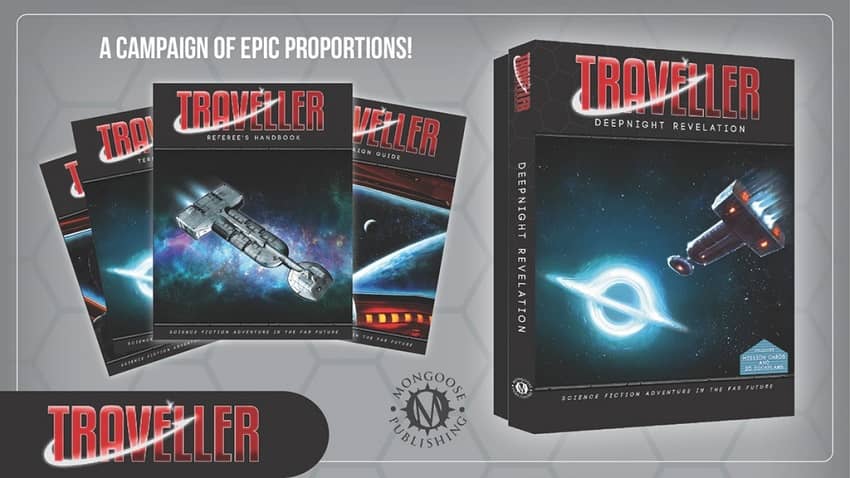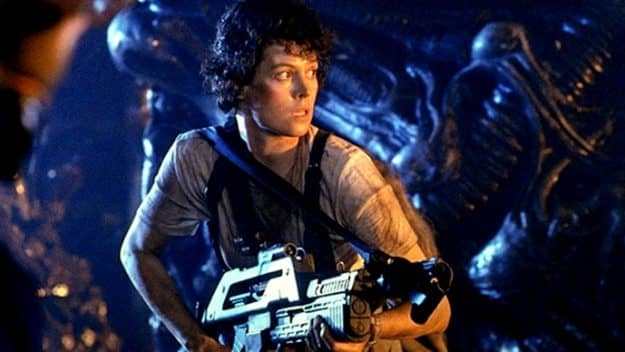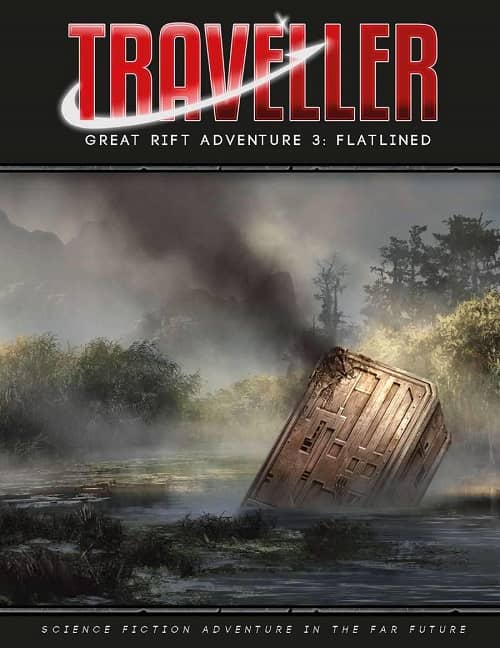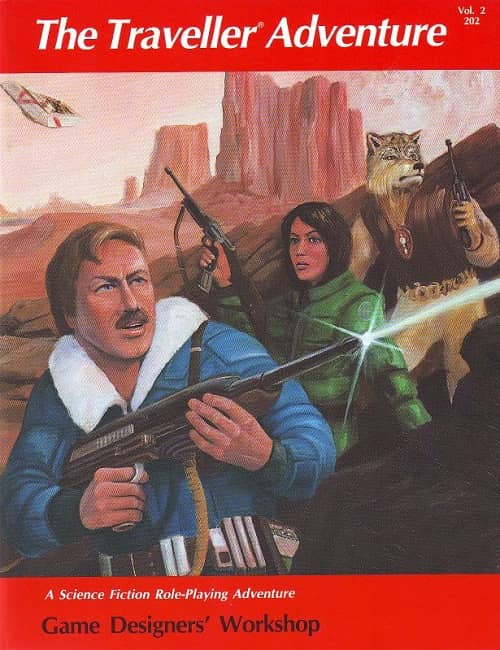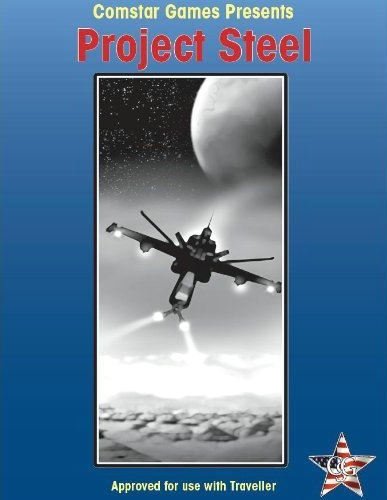Traveller Journeys into Deep Space with a New Kickstarter: An Interview with Martin Dougherty
Traveller RPG: The Deepnight Revelation Campaign Box Set
I’m a long time Traveller fan. It’s not just the simple but effective game system that’s been pretty much the same since its design, but the appeal of the sweeping hard science/space opera of the default setting, lovingly added to through the decades.
Of course you don’t have to use the Imperium as your setting, but a lot of people do, or use part of it, or use it with modifications. A new Kickstarter launched last week focused upon the exploration side of the Traveller universe. Many of the adventures and campaigns that have appeared for Traveller over the years have been focused upon small spaceship crews and their potential exploits, rather a lot like Firefly. This Kickstarter, though, is going to take a naval ship into areas unexplored by the Imperium, deep into the unknown. It looks splendid.
The man writing it is one of my very favorite adventure writers, Martin Dougherty, who never fails to entertain with clever and inventive scenarios that favor role-playing over rolls, and reward ingenuity. He was kind enough to take time away from writing the new campaign and answer some questions.
Howard: Before we really get started, what do you think is behind the appeal of Traveller, and the Imperium itself?
Martin: That’s a difficult question. I suspect it’s different for everyone. For me, I like the grounding in hard-ish science. I’ve never really got on with fantasy-in-space with swords the size of ironing boards and little actual science. The scale is attractive, too. For the most part it’s a bunch of resourceful people doing the best they can rather than superheroes. I know it’s fun to play someone incredibly far above the human norm sometimes, but I suspect a lot of us identify with the talented-but-ordinary protagonists of the typical Traveller game.
Sigourney Weaver as Ripley in Aliens (1986)
If you look at SF movies, there’s a parallel, I think. Aliens is one of my all-time favourite movies. True, Ripley is a badass – but she’s not a 26th level fighter with a giant sword, she’s a desperate starship crewmember who’s picked up a gun. Even the more fantasy-esque movies tend to feature relatively ordinary main characters. It’s easier to identify with a fairly normal person than with a magic hero, at least in an SF setting. It seems to work differently with fantasy games.
How is this Traveller campaign different from those that have come before?
Well, for one thing, it moves around a lot more. Normally you have a fairly fixed area where stuff happens. You might go off somewhere else but you could always come back. Deepnight Revelation is different; you’re on a voyage to a particular place and you won’t be doubling back to revisit places. Well, probably not. You can, of course, because….
This time around the Travellers have complete autonomy. And a heavy cruiser. Deepnight Revelation is the biggest and baddest thing in this region of space. The Travellers have a mission to complete but they are years from home. They make their own decisions about what to do and how to go about it, though there are always consequences.
Normally, at least in the stuff I write, you’re operating on a shoestring budget. This time you can go get another nuke out of the locker – yes, really – if the need arises. Of course, given the length of the mission the resources you have might not be as extravagant as they at first seemed, but that doesn’t change the fact that the Travellers are flying through space in a fortress armed with a cruiser-grade particle accelerator. It’s possible to bring a rather high level of force to bear on most problems.
There’s also the fact that it’s just plain gigantic. A journey of thousands of parsecs, though five regions – any one of which would be a decent campaign setting in its own right – to an epic finale on the edge of the spiral arm. My brief for the ending was to be a bit extravagant. I actually find that quite hard – I’m generally inclined to keep things small and tight.
Traveller: Great Rift Adventure 3: Flatlined by Martin J. Dougherty
By way of comparison…. The adventure Flatlined has the Travellers wake up in a sinking transport, with no weapons or even shoes. Getting out of the vessel, reaching safety and surviving the night are the big achievements. Food and shoes are major goals. And in Deepnight Revelation we’ve got Travellers sending people down to the vehicle bay to see how many of the ground vehicles are serviceable or checking none of the nukes are missing. The scale is… different.
Who do you think this campaign appeals to?
I think it will appeal to players who want to see the wonders of a fairly hard-science universe. Stuff that’s really out there – according to our current understanding of space science – with a few handwaves and the occasional rather extravagant extrapolation. By remaining within the confines of what’s known to be possible (mostly!) we’ve created a counterpoint to the amazing stuff – and a lot of that amazing stuff is backed up by real science. There’s no need to invent fantastic space phenomena when real science predicts frozen stars and worlds where it can rain diamonds.
In the Kickstarter updates you’ve mentioned hoping for at least six expansions, and four have already been cleared. Can you give us any hint about what more you would want to do if the Kickstarter continues to grow?
There’s a point in any large project where I start to promise myself I’ll have a breakdown and go live in the forest as a wild man once it’s finished. I might do that early if this thing grows much more. Failing that, I would like to expand on the various regions we’ve covered, or maybe do a spinoff about the planned follow-up missions. It’s likely we’ll keep adding more and more details – ships, places, aliens, animals, more adventures along the way.
How do you go about constructing a campaign? I know you’ve designed a lot of them over the years at this point.
That’s a surprisingly hard question. I’ve studied history extensively, and whilst I don’t like direct historical parallels looking at what people have done in the past does give an idea of what’s possible and what’s plausible. It’s important to remember that everything is connected – if there’s a super-powerful one-world polity in the middle of a backwater there has to be some reason why it doesn’t dominate the region.
I always take a top-down approach, starting with the big picture and moving to the details when they become important – and I’m willing to remove elements, no matter how awesome, that don’t fit. I think I was the first Traveller writer to do that. Previously the setting was developed in a piecemeal fashion and background was presented in locally-necessary library data. Effectively you got information on a twig, a branch and a pine cone but nobody pointed out that a forest was a thing.
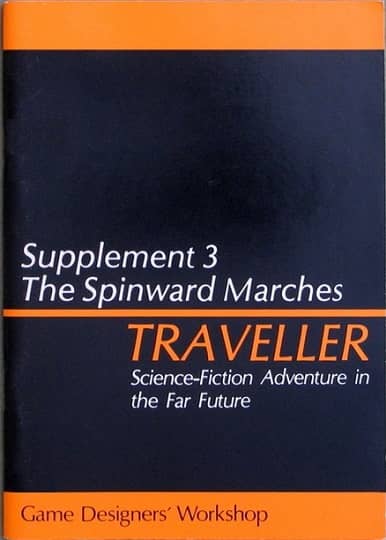 |
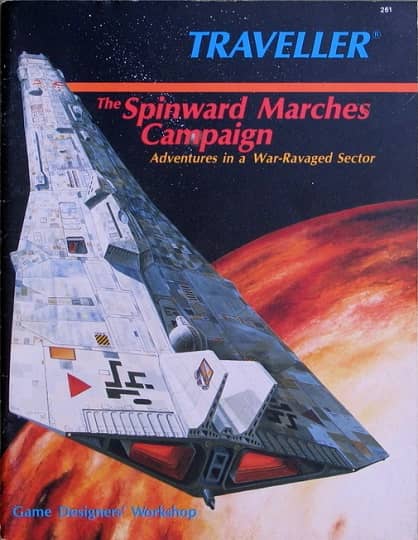 |
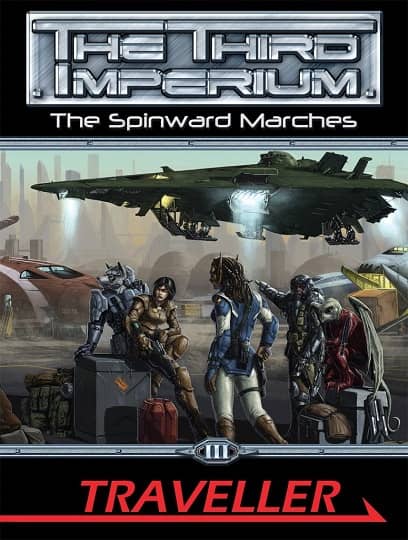 |
The Spinward Marches supplements: Game Designers’ Workshop (1979 and 1985), Mongoose (2008)
When I started playing you had, say, the Spinward Marches supplement with a map and a few notes on each subsector, and you had some local information in the adventures. There were Library Data compilations too, with some big-picture information, but there wasn’t much to tell you how it all fitted together. There was a move in the direction of overview-then-details but I think I was the first to start creating setting books in the current manner. I try to figure out how it all fits together and how the various factors influence one another.
I noticed that early on! I loved what you did with The Bowman Arm and Sector 268. I believe that you were the first who really fleshed out an entire sector, first from a zoomed out perspective with a little bit of information about the systems and worlds within (as well as campaign ideas and hooks). You would then zoom in with additional supplements to provide even more fine detail about some of the worlds in the same region. Now the talented Keith brothers were doing some of this prior to you, but you advanced it to the next level, and you seem to have set a standard others are trying to emulate. The story ideas just leap off the page and beg to be played. They’re fun, but they also made consistent sense – the worlds are interconnected and influence one another.
Kind of you to say so – I certainly tried my best and it’s nice to know I succeeded at least some of the time. Now that I think about it, The Traveller Adventure might have been the first product to detail multiple worlds with an attempt to explain how they interacted. However, that was an adventure rather than a sourcebook. I’m still claiming credit for a top-down sourcebook approach.
The Traveller Adventure (Game Designers Workshop, 1983)
The Keith brothers wrote (what I consider to be) the best Traveller materials in the early years. Especially Chamax Plague/Horde. I was heavily influenced by their work, I suspect. I’m pretty sure the JTAS article about world-building was one of theirs, and I know it influenced me.
I believe that everything must follow some internal logic even if the players never see it. Aliens may do weird stuff but they will do it for a reason. This is important, because it allows the players to make meaningful extrapolations from the data they have. If the setting is a mess of cool but inconsistent stuff the players don’t know what’s possible and what’s not, which in turn makes it harder to decide what to do. That’s not a problem in a campaign where everything is scripted and you just do the missions you’re given, but if you want to give the players the ability to make their own choices the setting must be internally consistent. The players may not know the reasons for something but they can observe and figure out at least a general idea of if-this-then-that. Without internal consistency the campaign can resemble a chaotic soup of cool ideas where the players cannot make informed decisions.
I was explaining to a friend why I love your adventures, and how I often buy them just to read even if I have no opportunity to run them. There’s sense of wonder, yet the sense that the challenges you present could be overcome by ordinary people with a heroic bent. You never fail to present intriguing situations that immediately get me wanting to play. Can you share any of your tips for adventure design? I know that you used to preface some of them with a discussion of Push, Pull, Enigma, and Reward, if I recall correctly.
The push, pull, enigma, reward thing originated with Marc Miller, I think. I believe it originally appeared in a T4 book. It’s an attempt to codify adventure elements, and like any attempt to nail something down with a neat definition the exceptions seem to squeeze out the harder you try to nail it all down. But it’s a good rule of thumb.
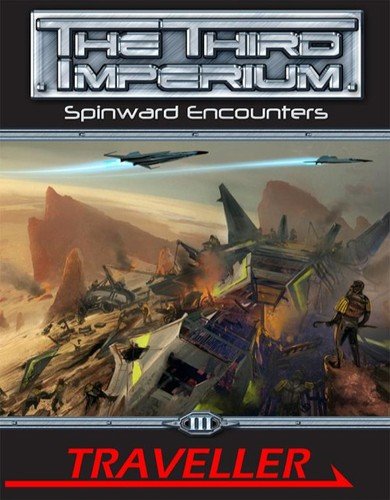 |
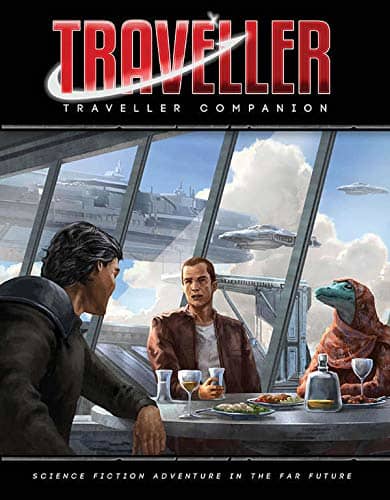 |
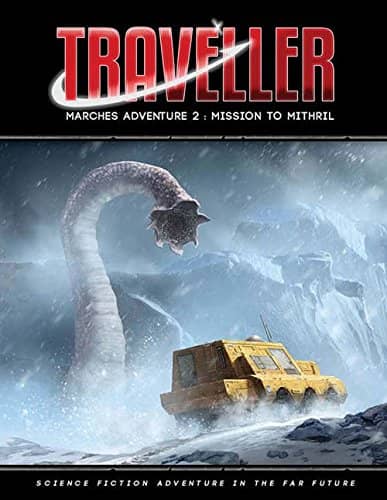 |
Mongoose Traveller products by Martin Dougherty: Spinward Encounters (2011),
Traveller Companion (2018), and Marches Adventure 2: Mission to Mithril (2018)
I try to avoid the sort of adventure writing that’s railroady or, worse, a chain of task checks. You get this sort of thing sometimes – ‘the Travellers must go down the corridor. Roll 8+ to get the door open. Then they must enter the control room. Roll 8+ for 1D guards’. That’s dry, boring and misses the whole point of adventure writing. You should never write what the Travellers must do, you should write what is there and what is happening and let the Travellers make choices. Sometimes there is only one good choice, but RPGs are about making choices, not dice rolls.
So I tend to set up a situation and turn the Travellers loose. I try to give the factions and groups logical goals and agendas, and make them as powerful as common sense says they should be. Events will unfold and the Travellers will react to them – or ignore them and do something entirely different – as they think best. That way the adventure becomes whatever story a particular group of players chooses to tell. In many cases you could play out a romance storyline among medical and disaster-relief staff with the adventure events as a backdrop, or a hard-hitting mercenary direct-action game, or anything in between. I see my role as creating an interesting situation and letting the Travellers deal with it their own way rather than trying to prescribe every single incident and skill check.
If we return to Aliens… the situation is that a colony has gone quiet and a ship arrives overhead. Nobody knows the colony has been overrun by alien monsters. The story that got played was one about a traumatised survivor and a platoon of marines… but what if an entirely different ship arrived? What if the Sulaco was a pirate ship needing a place to hide after a bad engagement? What if it was operated by cynical salvagers out to loot the colony? Or a fresh draft of colonists with virtually no weapons? Or a band of typical Travellers who have been led to believe they are about to investigate an Ancients site concealed beneath the colony? The same basic situation could play out different ways with different groups of Travellers.
Project Steel by Martin Dougherty (Comstar Games, 2013)
I’ve noticed that Mongoose is reprinting some of your great Avenger/Comstar work. Do you know if more is planned? I know I’m not alone in wanting to see Project Steel reprinted. It’s about impossible to come by these days.
We do plan to reprint Project Steel, either in its original form or perhaps moved to a different location. It’s one more plan in the Big Cauldron o’ Plans – we’re not short of ideas, just time to implement them.
Do you still get to game yourself these days?
No, not much. I occasionally put a game together to inflict my latest creation on someone – you could call that playtesting if you want. But despite my good intentions that doesn’t happen as often as it might.
Once this wraps up, I assume you’ll still be writing it for a while, but I can’t help wondering – what gaming products would you want to write next?
There was another candidate for a big campaign when we were developing Deepnight Revelation. That one will probably be next or soon, but I’m not sure if I’m supposed to say anything about that just yet. I would like to develop one or more of the expansions into a full setting for Traveller; somewhere completely new and open.
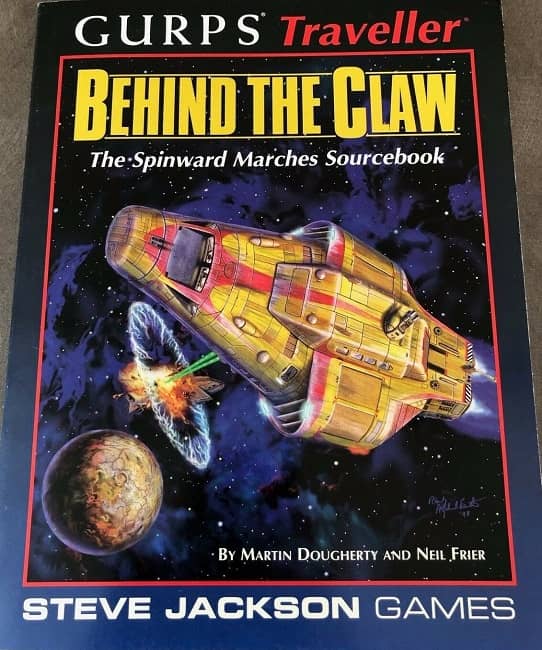 |
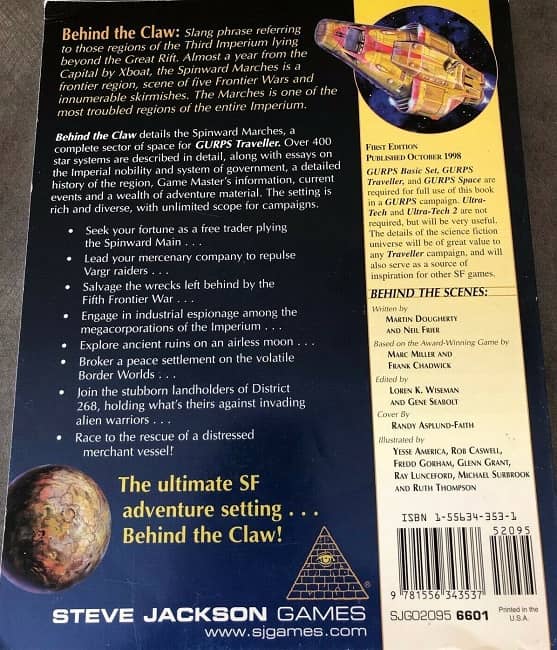 |
GURPS Traveller: Behind the Claw: The Spinward Marches Sourcebook, by Martin Dougherty and Neil Frier (Steve Jackson Games, 1998)
I’m also discussing the possibility of revisiting Gateway sector. I did some work on the K’kree for the aliens book; I’d like to expand on that and pick up the Lords of Thunder campaign from where it got to way back when. I also suspect that with the Behind the Claw book due out sometime soon I’ll be writing some adventures in that region. I think we’re redefined the setting-book for Traveller with BtC, and there will be others in the same vein. I want to have a look at the Solomani Rim and the surrounding region; there are plans to do that but it’s a question of what we do when.
Let me interrupt and explain to those not in the know that Behind the Claw refers to a sector of space where there’s a claw-like formation of stars on its 2D sector map. A lot of great adventures have been set in and around the area over the years. Will this new book give us more of them?
The new BtC book (not to be confused with the 1998 publication of the same title) details Spinward Marches and Deneb sectors, with a pile of ideas for adventures. I do have ideas for some full-size adventures set in the region. In fact, we have a 96-page campaign book due out soon. It’s set in the familiar region around the Bowman Arm, but it’s a chance to experience a merchant cruise from the point of view of the Sword Worlders. Things might look a little different from that side of the fence.
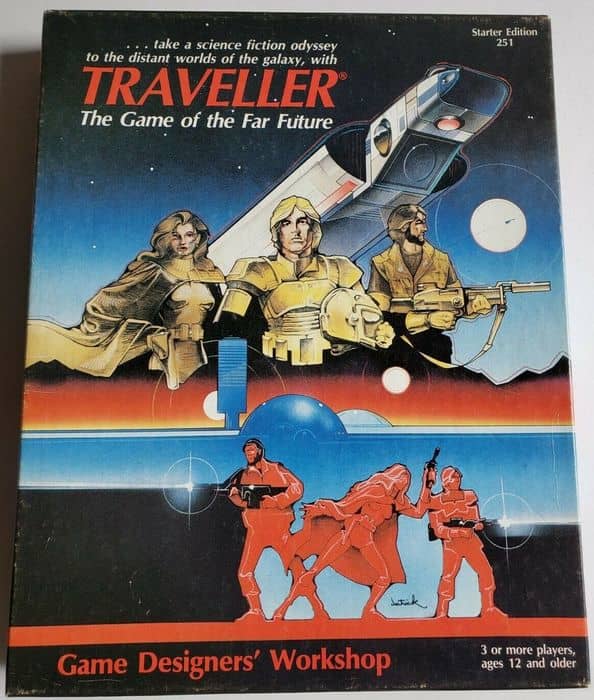 |
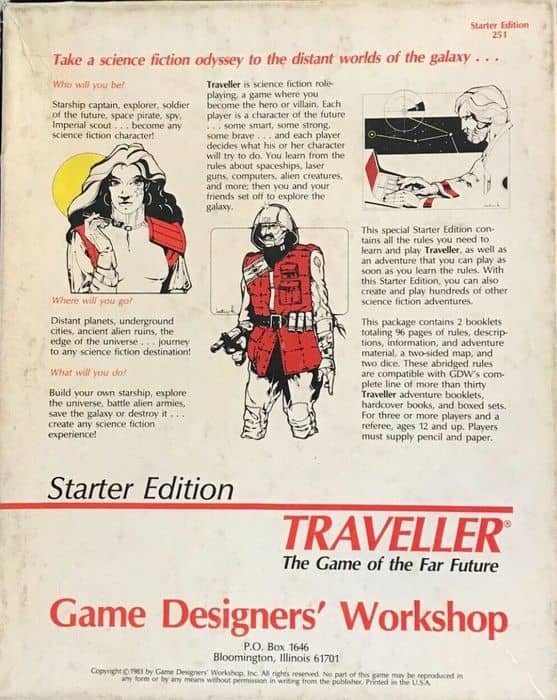 |
The Traveller Starter Edition: Game Designers’ Workshop (1983)
What do you do when you’re not drafting Traveller campaigns?
Games aren’t my day job. Most of my work is mainstream non-fiction books, with the occasional foray into magazines, new media and television. I’ve recently done a lot of myths and legends titles, a rather difficult project on Chinese armoured vehicles, a history of the so-called Dark Ages and the copy for a couple of photography-type books. You know, the sort where someone has taken a beautiful picture of a drystone wall in Ireland and I have to say something meaningful about it. Those are gorgeous books but the wild-man-in-the-forest thing looked more than usually attractive whilst I was working on them.
For recreation, it’s mainly swording. I moved from Olympic fencing to historical a good while back now. These days I teach smallsword and English military swordsmanship from the 1750-1850 period. That covers military sabre, backsword and what you might call the regimental broadsword. I became president of the British Federation for Historical Swordplay about four years ago and despite my best efforts I can’t seem to get myself fired. So whenever I escape from my desk I can usually be found at a fencing class or event, or maybe visiting a historical site. Living in the north of England there’s a lot of those within easy reach.
I’m also checking out suitable forests for the wild-man thing. Ever since I did that book on the Arthurian legends running off to be a crazy hermit has seemed like an ever more attractive solution to everyday problems. If it was good enough for Sir Lancelot (and others) it’s good enough for me….
Do you have a favorite of your non-fiction works you’d recommend? And do you have a favorite of your Traveller work?
I think The Ancient Warrior was probably the best book I’ve ever written, though you could make a case for Native American Warrior or the one I did on Central and South American civilisations. Favourite Traveller work? I’m not sure. Reft Sector is one of the best, but it was difficult to work on for various reasons so I don’t like it so much as I respect it. The adventure Deepnight Endeavour is a strong candidate for a favourite. I’ll probably think of loads more as soon as we finish.
Thanks for your time, Martin.
I’ll do anything rather than actually get on with my work….
The Deepnight Endeavor Kickstarter continues until December 1st. Drop by and see the marvels, and be sure to check out the additional details in the Updates section!
Howard Andrew Jones is the author of the critically acclaimed fantasy Ring-Sworn trilogy (the animated trailer for which can be found here), starting with For the Killing of Kings and continuing with Upon the Flight of the Queen, the historical fantasy novels The Desert of Souls, and the The Bones of the Old Ones, as well as the related short story collection The Waters of Eternity, and four Paizo Pathfinder novels. You can keep up with him at his website, www.howardandrewjones.com, and follow him on Twitter or follow his occasional meanderings on Facebook.
